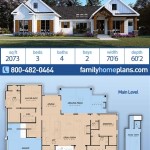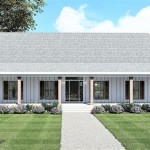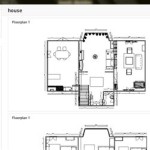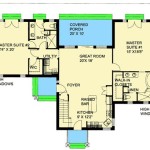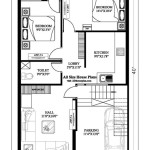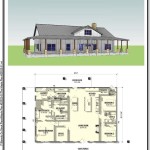Narrow Lot House Plans with Front Entry Garage: Optimizing Space and Functionality
Narrow lot house plans with front entry garages present a unique challenge and opportunity for homeowners and builders alike. These designs are specifically tailored to fit on narrower plots of land, maximizing living space while incorporating the convenience of an attached garage accessible from the front of the property. This article explores the key considerations, advantages, and design principles associated with narrow lot house plans featuring front entry garages.
In urban and suburban environments, land scarcity often leads to smaller lot sizes. Narrow lot house plans are a response to this condition, allowing for the development of residential properties in areas where traditional, wider lots are unavailable or prohibitively expensive. The integration of a front entry garage into these plans adds another layer of complexity, requiring careful planning to ensure efficient use of space, maintain aesthetic appeal, and adhere to local zoning regulations.
The appeal of a front entry garage lies in its accessibility and convenience. Homeowners can easily park their vehicles and access their homes without navigating through a backyard or side entrance. This is particularly advantageous in areas with inclement weather. However, the placement of the garage at the front of the house significantly impacts the overall design and street presence of the property.
Key Considerations for Narrow Lot House Plans with Front Entry Garages
Planning a narrow lot house with a front entry garage necessitates a comprehensive understanding of several critical factors. These factors range from site-specific constraints to the aesthetic integration of the garage within the overall architectural design.
Zoning Regulations and Setbacks:
Local zoning ordinances often dictate the minimum distance a building must be set back from property lines. These setbacks apply to both the house itself and the garage. Narrow lots typically have tighter setback requirements, which directly influences the buildable area and the placement of the garage. Understanding these regulations early in the planning process is crucial to avoid costly redesigns or construction delays. Height restrictions may also apply, further limiting design options.
Lot Orientation and Solar Exposure:
The orientation of the lot relative to the sun's path plays a significant role in energy efficiency and natural lighting. A south-facing orientation can maximize solar gain in colder climates, while an east- or west-facing orientation might require shading strategies to mitigate excessive heat during the summer months. The placement of the garage can also affect the amount of sunlight reaching the main living areas. Careful consideration should be given to window placement and the use of overhangs to optimize solar control.
Garage Size and Configuration:
The size of the garage should be determined based on the homeowner's needs and available space. Single-car or two-car garages are common options, but the width of the garage significantly impacts the overall width of the house. The configuration of the garage, whether it's a side-by-side layout or a tandem arrangement, also affects the design and functionality. Tandem garages, where vehicles are parked one behind the other, can be a space-saving solution for narrow lots, although they may be less convenient for households with multiple drivers.
Driveway Design and Access:
The driveway leading to the garage should be carefully designed to ensure easy access and maneuverability. The slope of the driveway, its width, and the turning radius required for vehicles should all be taken into account. In some cases, a curved driveway may be necessary to navigate around obstacles or to provide adequate turning space. Permeable paving materials can be used to reduce stormwater runoff and comply with local environmental regulations.Advantages of Narrow Lot House Plans with Front Entry Garages
Despite the challenges associated with designing houses on narrow lots, there are several advantages that make them an attractive option for many homebuyers.
Affordability:
Narrow lots are typically less expensive than larger plots of land, making them a more affordable option for first-time homebuyers or those looking to downsize. The reduced land cost can free up resources for building a higher-quality home or for other investments.
Efficient Use of Space:
Narrow lot house plans are specifically designed to maximize the use of available space. Architects and designers employ various strategies, such as open floor plans, vertical construction, and creative storage solutions, to create comfortable and functional living spaces within a smaller footprint.
Convenient Garage Access:
The front entry garage provides direct and convenient access to the home, particularly useful for carrying groceries or other items. It also offers a secure and sheltered space for parking vehicles, protecting them from the elements and potential theft.
Reduced Maintenance:
Smaller lot sizes generally require less maintenance than larger properties. This can translate to significant time and cost savings for homeowners in terms of lawn care, landscaping, and other outdoor upkeep tasks.
Community Integration:
Narrow lot developments often promote a sense of community by placing homes closer together. This can foster social interaction and create a more vibrant neighborhood environment.Design Principles for Optimizing Narrow Lot House Plans
Effective design is paramount to creating a narrow lot house that is both aesthetically pleasing and functionally efficient. Several design principles can be applied to optimize the layout and appearance of these homes.
Vertical Emphasis:
Since horizontal space is limited, vertical construction is often employed to maximize living area. Two-story or three-story designs can provide ample space for bedrooms, bathrooms, and other living areas without expanding the footprint of the house. Careful attention should be given to staircase placement to minimize wasted space and ensure easy access to all levels.
Open Floor Plans:
Open floor plans, where the kitchen, dining area, and living room flow seamlessly together, create a sense of spaciousness and allow for better natural light penetration. Eliminating interior walls can also improve circulation and make the home feel larger than it actually is.
Strategic Window Placement:
Windows should be strategically placed to maximize natural light and ventilation while maintaining privacy. Tall, narrow windows can bring in ample light without compromising wall space. Skylights and clerestory windows can also be used to introduce natural light into areas that might otherwise be dark. Consider prevailing winds and outdoor noise when planning window locations.
Efficient Storage Solutions:
Storage is often a challenge in smaller homes. Built-in shelving, under-stair storage, and other space-saving storage solutions can help to maximize available space and keep the home organized. Multi-functional furniture, such as sofa beds and storage ottomans, can also be used to optimize living space.
Curb Appeal Enhancement:
Because the garage is prominently featured at the front of the house, it is important to integrate it seamlessly into the overall design. Architectural details, such as decorative garage doors, complementary siding materials, and landscaping, can help to enhance the curb appeal of the property and create a welcoming street presence. Consider adding a covered porch or entryway to break up the mass of the garage and create a more inviting facade.
Landscaping and Outdoor Spaces:
Even on a narrow lot, it is possible to create appealing outdoor spaces. A small front garden, a side patio, or a rooftop terrace can provide valuable outdoor living areas. Vertical landscaping, such as climbing vines or wall-mounted planters, can also be used to add greenery and visual interest.In conclusion, narrow lot house plans with front entry garages require careful planning and design considerations to maximize space, functionality, and aesthetic appeal. By understanding the key factors, embracing the advantages, and implementing effective design principles, homeowners and builders can create attractive and comfortable homes that thrive in constrained urban environments.

20 Luxury Narrow House Plans With Front Garage Images Small Traditional Plan

Narrow Lot House Plans With Front Entry Garage Mind Blowing Home

Narrow Home Plans With A Front Garage Dfd House Blog

Simple Narrow Lot House Plans Houseplans Blog Com

Simple Narrow Lot House Plans Houseplans Blog Com

Narrow Lot House Plans With Front Garage 90 Two Floor

Narrow Lot House Plans With Attached Garage Under 40 Feet Wide

Narrow Lot House Plans With Front Entry Garage Mind Blowing Home

House Plan 3 Bedrooms 2 5 Bathrooms Garage 3877 V1 Drummond Plans

Narrow House Plans Lot Ranch Style

